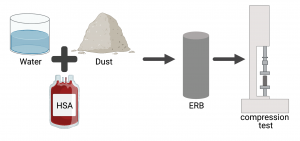With the human population continually increasing, people have envisioned where humans might reside if there is little space left on the surface of Earth. Over 70% of Earth is covered in water, so housing underwater is a possibility. Underground, too, could be a future residence. But most intriguing may be outer space, the final frontier. For humans to live anywhere other than Earth, habitable structures will need to be strong to withstand solar radiation, high speed winds, meteor impacts, and extreme differences in temperature, among other dangers. But to deliver the building blocks that would make up these structures would require space travel across long distances, which can be costly due to fuel usage as well as weight and capacity restrictions.
For humans to inhabit the Moon, Mars, or even exoplanets, voyagers will need to make use of building materials already present at these locations, such as rocks and dust. However, a study recently published in Materials Today Bio identified another source of building material – the voyagers themselves. The authors wondered if there was something in the human body that could be used, in combination with the rocks and dust present, to create structures and shelters strong enough to shield humans from the elements. Ideally, this “something” would be easy to collect, would be able to replenish itself, and could be used as structural glue or adhesive. This “something” is blood.
More specifically, within [human] blood is the protein human serum albumin (HSA). Serum albumin is the most abundant protein found in blood plasma; it comprises about 55% of this plasma and helps to keep blood within vessels and regulates clotting. HSA is easy to collect through plasma extraction, a commonly used method on Earth (think blood donation). Up to 40 grams of HSA can be found per liter of blood, and, in healthy adults, a quarter to half of that is replenished each day, meaning an adult can have normal levels of HSA within a week of blood extraction.
But how does one get stone from blood? The recipe is fairly simple: Mix HSA with water, infuse this mixture with dust, and allow everything to dry. What remains is solid structural material, called ERB (Extraterrestrial Regolith Biocomposite). However, if ERB structures are going to survive the elements of space, they need to be strong. The ERB was tested for its strength through compression tests – where pressure is placed on an object to see how much it can resist before it breaks – and was found to be as strong as concrete! The authors also found that the addition of urea, a component of human urine, made the ERB up to 300% stronger!

Created with BioRender.com
Limiting cargo on future space missions will be crucial and now there is a promise for using biological material from humans or animals (such as cows) to generate structural materials for use in space; however, the authors noted that human sources would be more feasible than taking cows to Mars.
Peer Edited by Nick Randolph
Hello my name is Nine. I’m frome Thailand.
I’m interested your topic about turn blood to stone can I ask you how. I’m jewelry maker by the way I want do make a jewelry from biology ^^